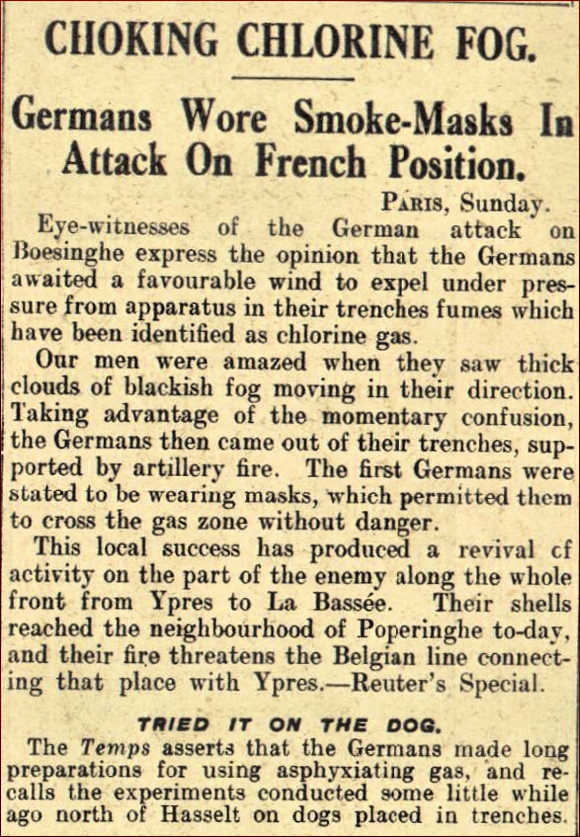For some years I've been interested in examining how newspapers covered unfolding, "breaking", major episodes from the war. I thought it would be particularly interesting to see, 1) how promptly news of the event appeared, 2) how generally accurate the material provided the public was, 3) the amount of detail that survived after passing through official censorship, and 4) if the reports contained any examples of clear misinformation.
Recently, wife and head researcher Donna discovered that the Library of Congress has fairly extensive holdings (April 1915–May 1916)—available online—of the wartime British newspaper Daily Sketch. I decided a good event to focus on from this period is the surprise opening to the Second Battle of Ypres, which was the first large-scale gas attack on the Western Front. Below are my clippings from the two issues that focused on the initial fighting. I believe that all mentions pertinent to the Second Ypres, which opened late in the day on 22 April are included. At the end of this article, I'll present a little journalistic scorecard based on the four points I listed above. By the way, on neither day did the outbreak of the battle, which—historically—was undoubtedly the Big News of the day, make the front cover.
Many people in Britain came to see World War I through the prism of the newspapers, all of which devoted extensive coverage to the war. The Daily Sketch was a British tabloid newspaper, established in Manchester in 1909 by Sir Edward Hulton (1869–1925), one of the leading newspaper proprietors of his era. Hulton soon moved the paper to London, where it competed with the other leading British tabloid, the Daily Mirror.
Hulton early recognized the possibilities of picture journalism, and the front and back pages of the Daily Sketch always were given over completely to photographs. During the war, however, these did not seem to include many combat action images. Most copy and almost all photos were dedicated to the wounded and to war heroes; information about the activities of the British royal family and other notables; news about the home front; features about women and families; short articles on political and social issues; cartoons; serialized stories; and advertisements. The wartime issues generally ran to 16 pages, sometimes 12.
24 April 1915 Issue
(No Sunday Edition)
26 April 1915
My "Scorecard" for the Reporting
1) Promptness:
Given that the gas attack began late Thursday and the usual fog and confusion of war, first reports with some level of detail appearing by Saturday seems impressive to me.
2) Accuracy:
On general points—the scale of the attack, the focus on the French section of the line, the use of gas, and the early German success—pretty good. Some details seem questionable but not crazy sounding.
3) Level of Detail and Censorship
The level of censorship can only be inferred, but it doesn't seem unreasonable given the military necessities. Never trust the casualty figures from the high commands is an eternal truth. It's quite impressive that the Daily Sketch was able and willing to quote German, French, and Belgian official statements, apparently unrevised. The level of detail was, as might be expected much improved on the second day of reporting.
4) Misinformation
I didn't spot any blatant cases, but readers are encouraged to post their observations in the comments section.
5) Overall
A surprising B+ for the editors and reporters of Daily Sketch.
Source: Library of Congress

















Excellent snapshot using those primary sources.
ReplyDeleteAgreed!
ReplyDelete